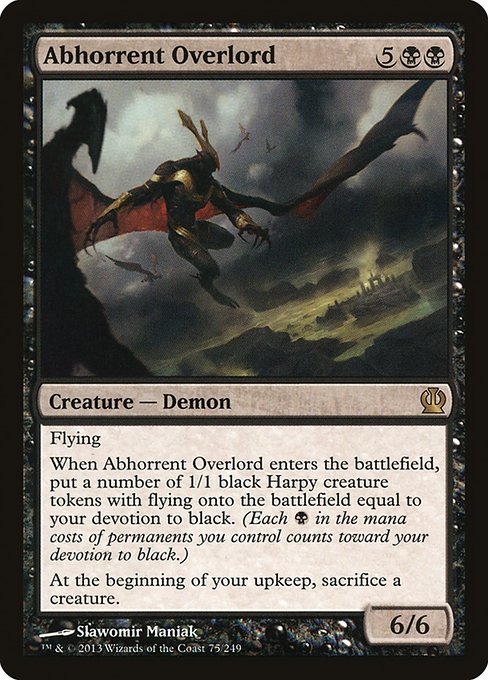
Image courtesy of Scryfall.com
Pivoting strategies after Abhorrent Overlord is countered
Counterspells happen. Some games hinge on a single, game-changing threat landing on the battlefield, only to be fizzled by a well-timed negate or void. When that happens with a powerhouse like Abhorrent Overlord, the immediate disappointment can feel personal—like opening a treasure chest and finding coal. But in Magic, a countered threat is not a dead end; it’s an invitation to pivot, to recalibrate your plan, and to lean into the parts of your deck that were always there, quietly edging toward inevitability. This piece digs into how to reshape your strategy mid-game when a seven-mana demon is denied entry, leveraging devotion, token engines, and graveyard resilience with a healthy dash of 🔥 flavor. 🧙♂️
Abhorrent Overlord is a rare from Theros, a black-aligned demon that arrives with a dramatic enter-the-battlefield payoff: you create a number of 1/1 black Harpy creature tokens with flying equal to your devotion to black. Your devotion is the magic metric you measure by counting the black mana symbols on permanents you control. In other words, the more black devotion you accumulate, the more Harpy bodies you spawn when Overlord hits the battlefield. All that flying chaff—er, “support”—can overwhelm an opponent when you’re able to keep the battlefield crowded with harrowing harpies, even as you juggle the upkeep penalty of sacrificing a creature at the start of your next turn. 🪙⚔️
But what if your plan to flood the board with Harpies is interrupted by a well-timed counterspell? Here are concrete pivots you can adopt in the moment, and as a broader deck-building philosophy that keeps black devotion alive even when your marquee threat is temporarily negated. 🧙♂️🎲
1) Lean into devotion-first value, not a single payoff
Abhorrent Overlord leans on its enter-the-battlefield token production, but devotion-to-black is the real engine. If your Overlord doesn’t land, the tokens don’t, either—but your ability to generate value from Black mana still exists. Emphasize other devotion-based payoffs in your list, such as Gray Merchant of Asphodel or other black staples that scale with devotion. When you can play a sequence that expands your life total or drains your opponents’ resources based on the same devotion you were counting for Harpies, you maintain pressure even after the counterspell—it’s a delayed victory condition, not a dead-end. 💎
2) Pivot to a token-synergy plan that doesn’t rely on Overlord
The Harpy tokens were never the sole reason to play the deck; they are the spark that lights a broader furnace. If Overlord is countered, you can pivot to other token generators—cards that produce flyers or swarm the board on different axes. Think of engines that convert mana into bodies, or that transform token presence into card advantage or life swing. Boards with a critical mass of flying creatures can pressure opponents quickly, and you’ll still be in the race even without the big demon at the helm. 🧙♀️🔥
3) Exploit graveyard resilience and recursion
Theros rarity aside, the game design around devotion and recursions is real. If Overlord is countered, you can lean into graveyard-oriented threats and reanimation loops. Cards that fetch back threats or reanimate key pieces can reset the board state and reestablish pressure. A well-timed reanimation spell can reintroduce a threat later in the game, letting you recover from the tempo swing a counterspell delivered. The key is to build a plan that doesn’t crumble when a single threat doesn’t resolve. 🔥🎲
4) Protect the plan with countermagic and disruption of your own
Countermagic isn’t just for the other guy. A compact suite of restoration spells—counterspells, removal, and protection—keeps your strategy flexible. If you anticipate disruption, you can deploy a controlled sequence of protective spells to ensure critical turns go your way. The moment your overlord is countered, you can pivot into a slower but stubborn line that leverages value from your other black sources, preserving the tempo and continuing to apply pressure. And yes, this is where the drama of a well-timed mana base and card draw pays off—every extra draw step is a new tool in your toolkit. 💎
5) Embrace the inevitability of synergy, not inevitability of one card
At its core, a resilient black devotion shell is about incremental advantage. Abhorrent Overlord is a dramatic centerpiece, but the deck should be designed so that the loss of a single card doesn’t derail the plan. Each game becomes a test of whether you can leverage devotion, token generation, and recursion in a way that compounds over time. If your opponent counters, you pivot to the long game: keep bodies on the board, drain life with devotion, and steadily outlast the rival’s disruption. And when you finally land a follow-up threat, you’re not starting from scratch—you’re continuing the momentum you created before the counterspell hit. ⚔️🎨
As you craft or refine your build, keep in mind the flavor of Theros: a world where devotions, pacts, and fates intertwine. The Overlord’s presence is big, but the magic of the deck is how you respond when the spell doesn’t resolve. You don’t need a single moment of victory to define the game; you need a thousand small moments of board presence, protection, and value. Grab those Harpy tokens and turn the page to the next chapter of your game plan. 🧙♂️💎
And if you’re enjoying the read while you’re on the go, there’s a companion way to stay stylish and organized—a practical Magsafe Card Holder Phone Case Polycarbonate you can grab for everyday carry. It’s a crisp reminder that strategy, like equipment, ages well when you keep your tools close at hand. Magsafe Card Holder Phone Case Polycarbonate 🧙♂️🎲
More from our network
- https://blog.digital-vault.xyz/blog/post/unveiling-hidden-multiplicity-in-a-blue-hot-giant-star-of-aquila/
- https://crypto-acolytes.xyz/blog/post/avoid-these-common-trading-mistakes-for-smarter-investing/
- https://crypto-acolytes.xyz/blog/post/parallax-driven-insights-into-stellar-evolution-from-a-distant-hot-giant/
- https://blog.digital-vault.xyz/blog/post/distant-blue-giant-in-octans-reveals-temperature-gradients-of-evolution/
- https://blog.digital-vault.xyz/blog/post/how-ai-accelerates-product-development-for-faster-innovation/